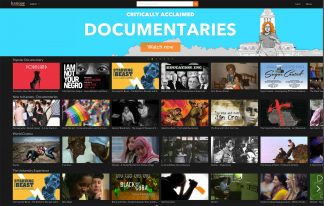There’s nothing new about using videos in the classroom. From projectors and film strips through VHS and Blu-ray players, instructors having been using video to augment and enhance their teaching for years.
Although the practice is traditional, evolving technology provides new scholarly affordances for instructors along with opportunities and challenges for libraries.
The University of Minnesota Libraries has started subscribing to online streaming platforms like Kanopy and Swank to meet the research and instructional needs of campus.
New opportunities with streaming video
“Having the video available digitally provides not only convenience, but also new opportunities for different ways of doing teaching and learning and research and scholarship,” says Scott Spicer, Media Outreach and Learning Spaces Librarian.
Different streaming platforms allow for different functionality but many include features for making clips, creating playlists, and integrating easily into course websites in Canvas or Moodle.
Streaming video titles Moonlight, The Truman Show, and I Am Not Your Negro, can be found like other library resources by searching the Libraries’ catalog. Streaming content can also be browsed on the Libraries’ streaming video web page.
“The stories that are told in documentaries and feature films can illustrate concepts and challenge students’ assumptions,” Spicer explains. “These videos do a great job illustrating very complex concepts in ways that are accessible to students.”
Along with feature films and documentaries the Libraries provides access to instructional videos like Anatomy.TV, SymptomMedia, and SAGE Research Methods.
Video can also be used to “flip the classroom” — instructors have students watch a video as class preparation, facilitating conversation and synthesis of ideas during class time.
Spicer stays on top of trends in university video use through his professional research. He recently co-authored a study on trends in video playback equipment in university classrooms and is currently researching in-class uses of video. He sees uses across the disciplines from courses on Shakespearean acting to nursing classes.
Robin Williams and communication theory
Instructor Alyssa Isaacs saw firsthand the benefits of integrating streaming video into her course, Introduction to Communication Theory. Isaacs created an assignment around the Robin Williams movie, Man of the Year. The assignment comes at the end of the semester and students are assigned to find examples and discuss the 29 different interpersonal, media, and rhetorical communication theories that were covered throughout the semester depicted in the movie.
Man of the Year encapsulates all of the theories covered. In recent years it had been harder and harder for students to get their hands on a copy of the movie, but no alternative worked as well in illustrating all of the theories discussed in the course.
“The amount of stress that I was getting from student emails saying, ‘I can’t get a hold of this’” Isaacs recalls, “I was looking at different libraries that would have it, online sources that would have it, trying to figure out if I could digitize my own copy.”
The value students got out of the assignment made switching to another, less relevant film an unattractive alternative. Requiring students to chose different film segments and write posts facilitated a rich online discussion.
She reached out to the Libraries and was put in touch with Spicer.
“Scott just was like, ‘Got it’ and ‘Here you go.’” Isaacs says.
Moving to the streaming version resulted in an end to access issue emails from students in the spring semester. Isaacs also saw 100 percent participation in the assignment for the first time with access barriers removed.
Challenges of a new format
The benefits of emerging technology bring along complexities inherent in collecting materials in a new format. Spicer and subject librarians are grappling with new subscription models, limited availability of individual titles, and content that cannot be licensed because it resides exclusively on entertainment websites like Netflix and AmazonPrime that are limited to personal use.
“There still is not nearly enough of the content that we know our instructors actually use that we could license even if we want to,” Spicer explains, “that opens up a whole lot of challenges for us as we continue to move forward.”
The libraries still have a rich collection of DVDs and VHS that instructors and students can draw on for their research and learning. These early steps into streaming access are a piece of long-term planning responding to playback options, instructor preferences, and format deterioration issues.
‘There’s this whole web of support’
Isaacs found that reaching out to the Libraries to learn about options was an invaluable practice.
“As an instructor it can be easy to forget all the resources we have available to us and it can feel like we need to figure everything out on our own,” Isaacs says. “In reality, if instructors have an idea they can just say, ‘Hey is this possible?’ and there’s this whole web of support that’s there for us that I would encourage all instructors to utilize.”






